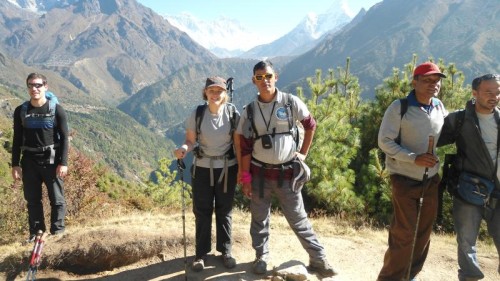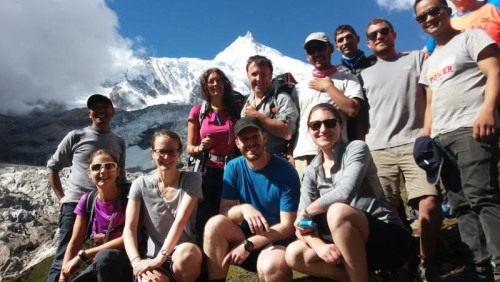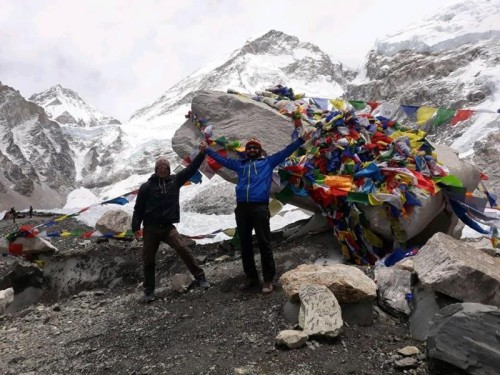Highlights of Upper Mustang Trek
- The Upper Mustang Trek is a journey into the remote and mystical former Kingdom of Lo, offering an unforgettable cultural and scenic experience in Nepal.
- This trek takes you through dramatic desert-like landscapes, colorful rock formations, and deeply eroded cliffs that resemble the Tibetan Plateau.
- One of the main highlights is the ancient walled city of Lo Manthang, rich with centuries-old monasteries, royal palaces, and Tibetan-influenced culture.
- Along the way, you’ll pass through traditional Mustang villages, where you can interact with local people and witness their preserved Buddhist way of life.
- The region’s isolation has helped retain its unique customs, architecture, and language, providing a rare cultural immersion.
- You’ll also enjoy panoramic views of the Annapurna, Dhaulagiri, and Nilgiri mountain ranges.
- The trek is ideal for those seeking a blend of cultural discovery, historical exploration, and high-altitude adventure in a restricted and less-crowded region of Nepal.
Summary of Guide to Hire for Upper Mustang Trek
Hiring a licensed guide is a mandatory requirement for the Upper Mustang Trek due to its designation as a restricted area by the Government of Nepal. Trekking without a registered guide and agency is not permitted. The region’s remote location, complex permit process, and unique cultural landscape make it essential to trek with a knowledgeable and experienced guide. A qualified guide will not only navigate the trail but also assist with obtaining the Restricted Area Permit (RAP) and Annapurna Conservation Area Permit (ACAP), manage logistics, and ensure your safety throughout the journey. Moreover, a good guide enriches your experience by explaining the deep-rooted Tibetan Buddhist culture, ancient monasteries, and hidden caves of Upper Mustang.
When hiring a guide for the Upper Mustang Trek, it's best to go through a reputable local trekking company like High Pass Adventure. Local agencies provide licensed, government-trained guides who are familiar with the terrain, fluent in English, and experienced in handling high-altitude trekking challenges. Choose a guide with a strong track record, excellent communication skills, and a passion for sharing knowledge about the region. By hiring a reliable guide, you gain more than just assistance—you gain a cultural bridge to the Mustang region and a trusted partner in one of Nepal’s most remarkable adventures.
Why Hiring a Guide is Mandatory for Upper Mustang Trek?
Hiring a guide for the Upper Mustang Trek is mandatory due to the region’s classification as a restricted area by the Government of Nepal. To preserve its unique Tibetan-influenced culture and sensitive border proximity with Tibet (China), all foreign trekkers are required to obtain a Restricted Area Permit (RAP), which is only issued through a registered trekking agency and requires the presence of a licensed guide. Independent trekking is strictly prohibited. This regulation ensures sustainable tourism, local benefit, and better monitoring of environmental and cultural impacts along the trail. A guide also facilitates the logistics of acquiring both the RAP and the Annapurna Conservation Area Permit (ACAP), making the pre-trek process smoother and legally compliant.
Beyond regulations, hiring a guide is essential for safety, navigation, and cultural immersion in this remote Himalayan region. The Upper Mustang trail passes through high-altitude desert landscapes, ancient cave systems, and traditional villages that can be challenging to navigate without local knowledge. A professional guide not only ensures your well-being in case of emergencies, altitude sickness, or unpredictable weather but also bridges the language gap, shares the historical and cultural significance of monasteries, gompas, and local customs, and enhances your overall trekking experience. In short, a licensed guide is not just a legal requirement for Upper Mustang—it’s your key to a safe, meaningful, and enriching journey.
How to Choose the Right Guide for Upper Mustang Trek?
Choosing the right guide for the Upper Mustang Trek is essential for ensuring a safe, enriching, and enjoyable journey through one of Nepal’s most culturally significant and remote regions. Since trekking in Upper Mustang requires a licensed guide due to its restricted status, it’s crucial to select someone who is not only government-certified but also has substantial experience in the region. Look for guides who are fluent in English or your preferred language, knowledgeable about the history, culture, and geography of Upper Mustang, and trained in high-altitude first aid. A good guide should also have experience handling altitude-related issues and logistics in remote areas, as well as the ability to arrange permits and coordinate with local authorities when necessary.
Additionally, it’s wise to choose a guide through a registered local trekking agency like High Pass Adventure. Local agencies often employ guides who are familiar with the terrain, weather patterns, and local communities of Upper Mustang, providing a more immersive and authentic experience. Read reviews, ask for references, and check the guide’s trekking credentials and past client feedback. A professional, friendly, and culturally sensitive guide will not only lead you along the trail but also help you connect with the region’s rich Tibetan-influenced heritage, ensuring your trek is both safe and unforgettable.
Cost for Guide, Guide cum Porter or Porter hire for Trek
|
Type
|
Cost Per Day (USD)
|
Includes
|
|
Guide
|
$35
|
Lodging, food, and trekking insurance
|
|
Porter Cum Guide
|
$30
|
Lodging, food, and trekking insurance
|
|
Porter
|
$25
|
Lodging, food, and trekking insurance
|
Other Costs for the Upper Mustang Trek - Cost Breakdown
Here’s a breakdown of the additional costs beyond hiring a guide and porter, such as permits for the Upper Mustang Trek, transportation, food, accommodations, and extras like hot showers, internet, charging, drinking water, and cold beverages:
- Upper Mustang Permit: USD 500 per person for a 10-day trek, plus USD 50 for each additional day.
- Annapurna Conservation Area Entry Permit (ACAP) and TIMS Card: USD 50 per person per trek.
- Accommodation Cost: USD 5 to 10 per night. Lodging is basic, typically with twin-sharing rooms.
- Food Cost: USD 25 to 40 per person per day, depending on how much you eat and spend. On average, one meal costs around USD 5 to 10.
- Transport Cost: Transportation costs vary based on the type of transport chosen. Here are some options:
- Flight (Kathmandu to Pokhara and return): USD 210 per person.
- Tourist Bus (Kathmandu to Pokhara, one way): USD 15 to 25.
- Flight (Pokhara to Jomsom): USD 170 per person.
- Public Bus (Pokhara to Jomsom): Approx. NPR 2,000 per person.
Total Estimated Cost:
The total cost for the Upper Mustang Trek ranges from USD 1,400 to 2,000 per person. This cost may vary depending on group size, chosen services, type of transportation, and duration of the trek.
This estimated cost typically includes all meals, transportation, guide and porter services, lodge accommodations, and all necessary permits.
Guide Hire vs Full Package for Upper Mustang Trek
When planning the Upper Mustang Trek, you have two primary options: hiring a guide only or booking a full package trek. Hiring a guide means you will need to pay the guide's daily wage and cover the costs of permits, accommodation, meals, and transportation separately. This option provides greater flexibility and can be more cost-effective for experienced trekkers who prefer to customize their journey and make on-the-go decisions.
In difference, booking a full package for the Upper Mustang Trek offers a hassle-free experience. The package typically includes all necessary permits (RAP and ACAP), transportation, accommodations, meals, a licensed guide, and porters. Trekking agencies handle all the arrangements, allowing you to focus entirely on the experience. This option is ideal for trekkers seeking convenience, safety, and local support throughout the journey. While a full package may cost more upfront, it often provides better value and peace of mind—especially in a remote and culturally sensitive region like Upper Mustang.
Upper Mustang Trek Difficulty: What to Expect on the Trail
The Upper Mustang Trek is considered a moderate to challenging trek, primarily due to its high-altitude terrain, arid landscape, and remote location. Although the trail itself does not involve technical climbing, trekkers should be prepared for long walking hours (5–8 hours a day) across rocky paths, dry riverbeds, and windy plateaus. The trek reaches an elevation of over 3,800 meters at Lo Manthang and crosses several high passes, including the Nyi La Pass (4,010m), which can be physically demanding, especially for those new to high-altitude trekking. The dry and dusty conditions of the trans-Himalayan region can also make the trek more tiring, and the lack of vegetation and shade ads to the challenge during hot days.
Despite its difficulty, the Upper Mustang Trek is very rewarding and accessible to trekkers with good physical fitness and a strong mindset. Prior trekking experience at altitude is helpful but not mandatory. Acclimatization is relatively manageable because the ascent is gradual, and the route offers teahouse accommodations, which eliminate the need for camping. What makes this trek truly unique is its cultural richness and scenic beauty—from ancient cave dwellings and centuries-old monasteries to dramatic desert landscapes and Tibetan-influenced villages. With the support of a knowledgeable guide and proper preparation, most trekkers who does the first time, find the Upper Mustang journey a physically challenging but spiritually enriching experience.
Why Choose High Pass Adventure for Upper Mustang Trek?
High Pass Adventure is a trusted local trekking agency in Nepal, known for its personalized service, experienced guides, and deep understanding of the Himalayan regions—especially remote and culturally rich areas like Upper Mustang. Choosing High Pass Adventure for your Upper Mustang Trek means you’ll be guided by a team that prioritizes your safety, comfort, and immersive experience. Their guides and porters are not only professionally trained and government-certified but are also deeply familiar with the region’s history, terrain, and Tibetan-influenced culture, ensuring you gain meaningful insights throughout your journey. From obtaining special permits to organizing reliable transportation and accommodations, they handle every logistical detail with care and transparency.
What truly sets High Pass Adventure apart is their commitment to sustainable and responsible tourism. They maintain strong relationships with local communities, support eco-friendly trekking practices, and ensure that your visit benefits the region directly. Whether you’re a solo traveler or part of a group, they offer flexible itineraries tailored to your schedule, budget, and interests. With 24/7 support and a reputation for going the extra mile, High Pass Adventure ensures your Upper Mustang Trek is not just a trip, but a once-in-a-lifetime cultural and scenic adventure you’ll always remember.












 USD 30
USD 30




Carol
Australia
Ganesh Karki Best Tour and Trek Guide Ever
16th June, 2019
I have just completed a 15-day tour and trek in the Upper Mustang Valley with Ganesh, the founder of High Pass Adventure. The service provided by Ganesh was truly first class — he is the best tour and trekking guide I have ever had, and I’ve traveled extensively over the past ten years.
Ganesh is one of the most caring individuals you could hope to meet, especially when you're far from your comfort zone. The Upper Mustang is a very remote region, and as a first-time trekker, I felt completely safe under his guidance. The scenery was breathtaking, the mountains were steep, and the nights were cold — but Ganesh was always there with a warm smile at breakfast, lunch, and dinner.
Thank you, Ganesh, for an unforgettable life experience. I will definitely reach out to you again and wholeheartedly recommend you to my friends the next time I visit Nepal.